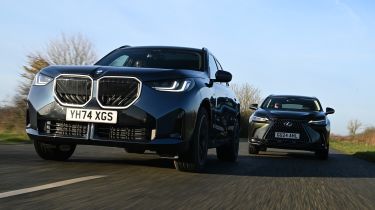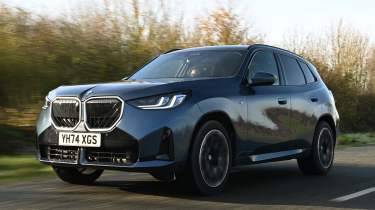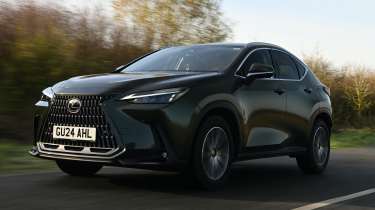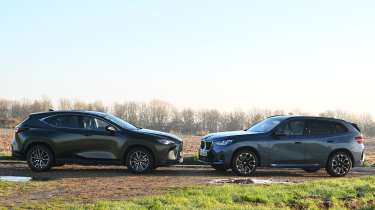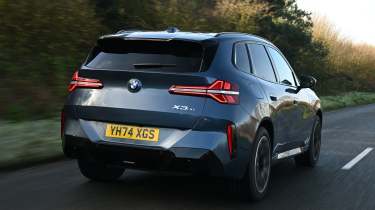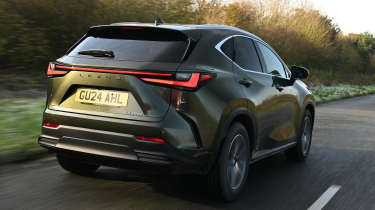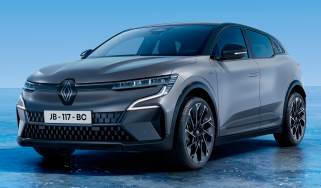BMW X3 vs Lexus NX: which premium mid-size SUV takes top honours?
BMW’s much-lauded new X3 is one of the best luxury compact SUVs on the market – but is it good enough to topple the cheaper hybrid-powered Lexus NX 350h?
Premium SUVs are big business. Desirable badges, chunky designs and space for all the family mean that wealthy buyers can’t get enough of them. And nowhere is that more evident than among the upmarket German brands.
In the past couple of years, some of the greatest successes among the “big four” have been with their mid-size SUVs; Audi’s most popular car is the Q5, for Mercedes it’s the GLC, for Porsche it’s the Macan, and BMW’s top seller is the X3, having initially created the formula that many others now emulate. So, when an all-new X3 is let loose, it’s a big deal.
Bold styling, more tech than ever and better refinement mark out BMW’s newcomer, but will it be enough to overcome such a broad and talented range of competition?
With so much focus on the German brands, Lexus often flies under the radar of many buyers – especially in the UK. And if past experience of the Lexus NX is anything to go by, that’s a shame, because it’s a superb offering. Indeed, it’s our reigning mid-size Premium SUV of the Year – and has been for several years. In other words, there will be no tougher test for the BMW than this one.
BMW X3
| Model: | BMW X3 20 xDrive M Sport |
| Price: | £50,175 |
| Powertrain: | 2.0-litre 4cyl petrol, 187bhp, plus 17bhp HEV motor |
| 0-62mph: | 7.8 seconds |
| Test efficiency/range: | 35.1mpg/502 miles |
| Annual VED: | £590 |
The original BMW X3 was one of the first models to kick off the mid-size premium SUV segment, and after two decades of refinement, there are still some areas where its rivals struggle to compete. Driving dynamics and tech are two trump cards for the latest model, but in its weakest areas, it’s average at worst. Pricing is competitive when compared against its key challengers, with the entry-level model undercutting the most affordable Mercedes-Benz GLC, and running the ageing Audi Q5 very close.
Used - available now

2022 MG
HS
12,807 milesAutomaticPetrol1.5L
Cash £16,287
2021 Citroen
C1
11,182 milesManualPetrol1.0L
Cash £9,487
2017 Vauxhall
Insignia
96,309 milesManualDiesel1.6L
Cash £4,500
2019 Land Rover
Range Rover Evoque
94,100 milesManualDiesel2.0L
Cash £8,750Tester's notes
The X3 is yet another addition to the world of ever-expanding SUVs. It has grown by 34mm in length and is 29mm wider than its predecessor. It is also 25mm lower than before, although in the metal it almost looks like the opposite is true. A mix of an upright nose (fronted by a grille with pin stripes that clash at different angles), a high bonnet and a tiptoe-ish stance means that it doesn’t quite appear as squat and purposeful as the car it replaced. Maybe we’ll have to wait for a full-fat M model for that.
BMW gives buyers a reasonable level of scope for customisation both inside and out. Those who want a full leather interior can go for a snazzy tan/grey combination or a fully black finish, while artificial leather is offered in brown, cream or black. There’s even a fabric option, with the woven grey material adding some extra interest inside. On the outside, wheel sizes range from 18 to 21 inches, and there are nine exterior paint finishes to choose from – white is the only no-cost option.
Lexus NX
| Model: | Lexus NX 350h Premium AWD |
| Price: | £47,245 |
| Powertrain: | 2.5-litre 4cyl petrol, 178bhp, plus 178 bhp and 53bhp HEV motors |
| 0-62mph: | 7.7 seconds |
| Test efficiency/range: | 44.8mpg/542 miles |
| Annual VED: | £590 |
The Lexus NX is a well known quantity in this class, and as its multiple gongs in our New Car Awards in recent years prove, it’s one of the best SUVs around. A range of efficient powertrains mated to many strengths that you’d expect from Lexus – chiefly refinement and reliability – with others that are more of a surprise, such as keen driving dynamics and a competent infotainment system, entirely justifies the NX’s spot among the class leaders. Each passing year makes it harder to cling onto top spot, however, and with the new X3 and second generation Mercedes GLC to contend with – plus an upcoming Audi Q5 – it certainly has its work cut out.
Tester's notes
At a time when many manufacturers are playing it safe with the colour palette, it’s refreshing to see Lexus be a little more daring with some colours. Take the Sonic Copper option; the almost rose-gold look was introduced on the all-electric Lexus RZ, and while it won’t be to everyone’s taste, I’m glad that it exists. I’m fond of the Terrane Khaki (£770) finish of our test car. I’d pair that with a tan interior (Hazel, in Lexus speak) – even if that means upgrading to the Premium Plus trim.
Hybrid cars and PHEVs are a great stepping stone into full EV ownership, and Lexus offers two compelling reasons to hold out on that tech compared to other brands. The first is that it does hybrids better than almost anyone else, while the other is that its EVs aren’t yet up to the high standards of some rivals. The similarly sized all-electric RZ is great to drive and fairly quick, but when it comes to overall range and efficiency, it can’t compare with the best alternatives for the money.
Head-to-head
On the road
While the Lexus delivers an impressive ride and handling balance, the BMW exposes one or two areas where the Lexus could improve. The X3 rides more firmly over bumps, yet it’s also more capable of filtering out smaller imperfections than its rival. It’s quieter at a cruise, too. Despite this, it’s also the sharper of this pair to drive. While the Lexus handles more keenly than many rivals, the X3 is even more responsive.
Tech highlights
BMW has offered buyers a wide range of powertrain choices, with mild-hybrid petrol, diesel and plug-in hybrid options, plus a lusty six-cylinder petrol. A full EV will take the form of an all-new BMW iX3 running on a new platform. The Lexus, meanwhile, remains resolutely hybrid. There’s the choice of a full hybrid (in two or four wheel drive) and a plug-in variant, both of which are smooth and frugal during everyday driving.
Price and running
For a petrol SUV weighing the best part of two tonnes, the X3’s mid-30s mpg in a wide range of driving situations is respectable – especially because it rarely feels like you’d need more performance. The NX is more frugal still, doing its best work in town, where the benefits of its hybrid system come to the fore. The NX also brings the added bonus of class-leading residuals – but the BMW’s beat most other rivals.
Practicality
Neither of these cars feels cramped, and while neither is quite at the top of the class when it comes to overall cabin space, both will be fine even if you need to regularly carry six-footers in the back. The NX’s 521-litre boot capacity will be more than enough for most buyers, but it does put it towards the bottom of the class for storage. The X3 fares better here, delivering a much roomier 570-litre load bay.
Safety
While the BMW X3 hasn’t been tested by Euro NCAP yet, we predict a strong showing. Every edition is loaded with safety tech as standard, while the options include a 360-degree parking and junction camera, adaptive cruise control with self-steering and an interior camera monitoring system. The NX can’t quite match the X3’s level of assistance, but still achieved a maximum five-star Euro NCAP rating in 2022.
Ownership
Lexus has a strong reputation for its ownership experience (plus the lure of a 10-year warranty tied into regular dealer services), but our 2024 Driver Power survey saw the brand take a 12th-place finish out of 32. That’s comfortably in the top half, but not at the level we’ve come to expect from the Japanese maker, and only two places above BMW. In pure reliability terms, Lexus was seventh overall and BMW 11th.
Verdict
Winner: BMW X3
It has won by the tightest of margins, but the BMW X3 is the car that has at long last overcome the Lexus NX in the hotly contested mid-size premium SUV segment. It scores strongly across the board, with great driving dynamics, a big boot, superb in-car tech and a range of excellent powertrains that are enough to narrowly scrape a victory in this contest. We’ll be keen to revisit the X3 to see whether our test car’s patchy build quality was just a blip on an early production model or a deeper issue, but that fit-and-finish question mark aside, it’s a difficult car to fault.
Runner-up: Lexus NX
It's taken several years for a rival to reach its level, but the time has finally come for the NX to settle for second place. There’s still a huge amount to like though, to the point where we’d completely understand if it remains the preferred choice for many buyers. Superb fuel efficiency (regardless of powertrain), class-leading warranty support and excellent build quality are all areas where even the BMW struggles to match it, but the X3 shows it up in some other areas – notably practicality and infotainment tech. Still, there’s very little to actively criticise, despite its runner-up spot.
Prices and Specs
| BMW X3 | Lexus NX | |
| Our choice | BMW X3 20 xDrive M Sport | Lexus NX 350h Premium AWD |
| Price from/price of our choice | £48,375/£50,175 | £47,245/£47,245 |
| Powertrain and performance | ||
| Engine | Four-cyl in-line/1,998cc | Four-cyl in-line/2,487cc |
| HEV Motor(s) | 17bhp/20Nm | 178/270 & 53/121 bhp/Nm |
| Power/torque | 187bhp/310Nm | 241bhp/ 227Nm/391Nm (petrol/electric) |
| Transmission | Eight-speed auto/4WD | eCVT auto/4WD |
| 0-62mph/top speed | 7.8 secs/134mph | 7.7 secs/124mph |
| Fuel tank/battery capacity | 65 litres/0.96kWh | 55 litres/1.0kWh |
| MPG (WLTP/test)/range | 39.2/35.1mpg/502 miles | 47.0/44.8mpg/542 miles |
| CO2 | 163g/km | 136g/km |
| Dimensions | ||
| Length/wheelbase | 4,755/2,865mm | 4,660/2,690mm |
| Width/height | 1,920/1,660mm | 1,865/1,660mm |
| Rear kneeroom | 605-835mm | 639-856mm |
| Rear headroom/elbow room | 951/1,455mm | 939/1,468mm |
| Boot space (seats up/down) | 570/1,700 litres | 521/1,411 litres |
| Boot length/width/lip height | 940/1,117/764mm | 961/1,005/790mm |
| Kerbweight/towing weight/turning circle | 1,930/2,400kg/12.2 metres | 1,870/1,500kg/12.4 metres |
| Costs/ownership | ||
| Residual value (after 3yrs/36,000 miles) | £28,023/55.85% | £27,275/57.73% |
| Depreciation | £20,352 | £19,970 |
| Insurance group/quote/VED | 32/£927/£590 | 36/£1,320/£590 |
| Three-year service cost | £1,044 | £1,435 |
| Annual tax liability std/higher rate | £3,560/£7,121 | £3,103/£6,205 |
| Annual fuel cost (10k miles) | £1,799 | £1,409 |
| Basic warranty (miles)/recovery | 3 years (unlimited)/3 years | 3 years (60,000)/1 year |
| Driver Power manufacturer position (2024) | 14th | 12th |
| NCAP Adult/child/ped./assist/stars | TBC | 91/87/83/91/5(2022) |
| Equipment | ||
| Metallic paint/wheel size | £875/19 inches | £770/18 inches |
| Parking sensors/camera | F&r/yes | F&r/360 degrees |
| Spare wheel/Isofix points | Repair kit/two | Repair kit/two |
| Keyless entry & go/powered tailgate | Yes/yes | Yes/yes |
| Leather/heated seats | £2,150/yes | Yes/yes |
| Screen size/digital dashboard | 14.9 inches/yes | 14.9 inches (£1,500)/yes |
| Climate control/panoramic sunroof | Yes/£1,350 | Yes/£1,450 |
| USBs/wireless charging | Four/yes | Four/yes |
| Wireless Apple CarPlay/Android Auto | Yes/yes | Yes/yes |
| Blind-spot warning/head-up display | Yes/£2,275 (Part of pack) | Yes/no |
| Adaptive cruise/steering assist | £2,275/£2,275 (Part of pack) | Yes/no |

